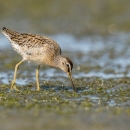Seasons of Wildlife
Spring
A massive influx of shorebirds begins in late April and continues through mid-May as birds journey north. This is the spring migration, subject of the Grays Harbor Shorebird and Nature Festival, typically held at the refuge during the last weekend in April or the first weekend in May, depending on tides. Hundreds of thousands of shorebirds stop to rest and feed on the vast mudflats in Grays Harbor. After a brief stay, the birds move north along the coast of British Columbia and reach the Copper River Delta in southeast Alaska. Then it's on to their breeding grounds, where long days and abundant food provide an ideal place to nest and raise their young. While visiting Grays Harbor in the spring, expect to see large numbers of Western sandpipers, dunlins, short-billed and long-billed dowitchers, and semipalmated plovers, as well as black-bellied plovers, red knots, and least sandpipers. Western sandpipers and dunlins compose 80 percent of the shorebirds present in the spring.
Summer
Fall migration begins in July when shorebirds begin to arrive in Grays Harbor National Wildlife Refuge. Shorebirds leave their breeding grounds at different times, so fall migration is less concentrated than spring migration and lasts through September. While most shorebirds continue moving south, thousands of shorebirds, primarily dunlin, will winter along the Washington coast.
Fall
Migratory waterfowl return to the refuge. Large flocks of dunlins attract predators such as peregrine falcons. In the woodland, as leaves fall and insects disappear, summer songbirds such as common yellowthroats head to warmer climes.
Winter
Weather is rainy and cold - dress warm and bring a waterproof outer layer. Waterfowl, including mallards, American wigeons, and northern pintails are most abundant at this time of year; and some shorebirds, such as dunlins, also winter over at the refuge. Raptors, including peregrine falcons, bald eagles, northern harriers, and red-tailed hawks are most abundant at this time of year.
Featured Species
There is nothing more critical to the establishment of healthy animal communities than habitat. At the refuge, at least four distinct natural habitats work together to create a richness of biodiversity rare even for the Pacific Northwest: estuary, open salt water, saltmarsh, and mudflats.
Estuaries, places where salt and freshwater mix, are some of the most biologically productive ecosystems on the planet. These tidally driven areas of transition between land and sea are home to a tremendous variety of plants and animals, are rich in nutrients, and provide the basis for the food chain. Open water offers an area with abundant food resources for western grebes, double-crested cormorants, common loons, and Caspian terns. Black brant feed on the eel grass beds, and ducks feed at the waterline. Harbor seals hunt for fall Chinook and chum salmon.
Salt tolerant plants such as tufted hairgrass, Lyngby's sedge, Baltic rush, and pickleweed surround the mudflat and provide cover and a resting place for birds during high tide. Saltmarsh plants also contribute small plant particles that fish and invertebrates consume, and provide habitat for invertebrates and crustaceans. Migratory waterfowl and geese nest and feed among grasses and sedges on the saltmarsh. Red-tailed hawks, merlin, peregrine falcons, and northern harriers hunt prey over saltmarshes.
Twice a day, as the tide recedes, vast expanses of mud are exposed. Although it may not look like it, mudflats are a banquet table for birds. Within a square meter of mud, there may be up to 50,000 individual invertebrates! More than 90 percent of these tiny animals are found within the top five centimeters of mud. This abundant food enables shorebirds to gain up to 30 percent of their body weight in fat prior to resuming their travels. As the tide rises to cover the mudflats, nutrients are delivered again to the invertebrates-- their turn to feed.
From late April to early May, hundreds of thousands of shorebirds stop to rest and feed on the vast mudflats in Grays Harbor. After a brief stay, the birds move north along the coast of British Columbia and reach the Copper River Delta in southeast Alaska. Then it's on to their breeding grounds, where long days and abundant food provide an ideal place to nest and raise their young. About two dozen species of shorebirds use the refuge during spring and fall. Most shorebirds can be identified by where they forage on the mudflat and the feeding methods they use. Coloration and physical shape also help you identify the species. Explore the migration of shorebirds in this storymap, produced by the Smithsonian Migratory Bird Center.
Many other species live in the refuge. Resident birds such as common yellowthroat, marsh wrens, and black-capped chickadees can be heard in the willow thickets. Finches, sparrows, and swallows can be observed during different seasons. Low flowering shrubs provide food and nesting areas for hummingbirds and warblers. Red-tailed hawks nest in the alders. Woodland shrubs such as salal, thimbleberry, salmonberry, blackcap raspberry, and blackberry produce fruit that is eaten by robins, cedar waxwings, deer, coyote, and small mammals.


